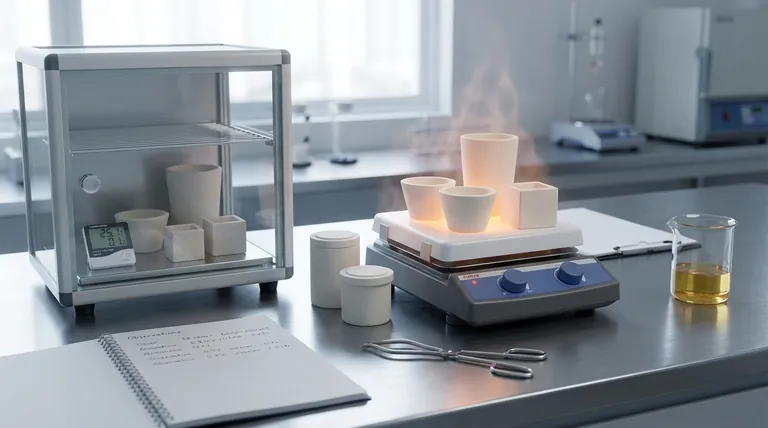In practical terms, no. While cannabinoids can technically turn into a vapor, they do not evaporate at room temperature in the way water does. For cannabinoids to vaporize, they must be exposed to significant heat, far higher than any normal environmental condition.
The core issue you should be concerned with is not evaporation, but degradation. Cannabinoid potency is lost over time due to exposure to air, light, and heat, which chemically breaks them down, rather than causing them to float away.

The Science of Cannabinoid Volatility
To understand why your cannabis products are stable at room temperature, it's crucial to distinguish between two related concepts: evaporation and vaporization.
Evaporation vs. Vaporization
Evaporation is a surface-level process where a liquid turns into a gas at a temperature below its boiling point. It happens slowly and depends on factors like air flow and humidity.
Vaporization, on the other hand, is the rapid phase transition from liquid to gas that occurs when a substance is heated to its boiling point. This is a deliberate and energetic process.
The High Boiling Points of Cannabinoids
Cannabinoids are heavy, complex molecules with very high boiling points. They simply do not have enough energy to turn into a gas under normal conditions.
- THC (Tetrahydrocannabinol) has a boiling point of approximately 157°C (315°F).
- CBD (Cannabidiol) has a boiling point between 160-180°C (320-356°F).
These temperatures are why methods like vaping and dabbing are effective—they are specifically designed to heat the product enough to intentionally vaporize the cannabinoids for inhalation.
The Real Threat to Potency: Degradation
If cannabinoids aren't evaporating, why does old cannabis lose its effect? The answer is chemical degradation. This is the true risk to your product's quality and the primary factor you need to manage.
The Role of Oxygen (Oxidation)
Exposure to air is the most significant enemy of THC. Oxygen molecules cause a process called oxidation, which converts psychoactive THC into CBN (Cannabinol).
CBN is only mildly psychoactive and is known more for producing sedative effects. Over time, this conversion directly reduces the primary desired effect of the product.
The Impact of UV Light
Light, particularly UV light from the sun, acts as a powerful catalyst. It provides the energy needed to accelerate the degradation process, breaking down cannabinoids at a much faster rate than it would in the dark.
The Effect of Modest Heat
Even heat well below the boiling point can be damaging. Storing products in a warm environment (like a hot car or a sunny windowsill) speeds up the rate of all chemical reactions, including oxidation, accelerating the loss of potency.
How to Properly Preserve Your Cannabinoids
Understanding the real threats—air, light, and heat—allows you to take simple and effective steps to preserve the quality and potency of your products for months or even years.
For Cannabis Flower
The goal is to create a stable environment. The best method is storing flower in airtight glass jars in a cool, dark place like a cupboard or closet. This protects it from all three degrading elements.
For Concentrates and Oils
Concentrates and oils are also susceptible to degradation. They should be stored in airtight, light-proof containers (glass or silicone are common). For long-term storage, refrigeration can significantly slow degradation, but ensure the container is truly airtight to prevent moisture contamination.
Making the Right Choice for Your Goal
Based on this understanding, your storage strategy should align with your specific product and timeline.
- If your primary focus is short-term flower storage: An airtight glass jar kept in a dark cupboard is more than sufficient to maintain freshness and potency.
- If your primary focus is long-term preservation of concentrates: Use a small, airtight container and store it in the refrigerator to dramatically slow the degradation process.
- If your primary focus is consumption via vaping: Understand that your device is engineered to intentionally heat the product to its boiling point, achieving the vaporization that does not occur naturally.
By controlling the environment, you take direct control over the quality and lifespan of your products.
Summary Table:
| Factor | Effect on Cannabinoids | How to Protect |
|---|---|---|
| Oxygen (Air) | Converts THC to less potent CBN | Store in airtight containers |
| UV Light | Accelerates chemical breakdown | Keep in a dark place |
| Heat | Speeds up degradation reactions | Store in a cool environment |
Protect your investment and ensure consistent results. Proper storage is key to maintaining cannabinoid integrity. KINTEK specializes in lab equipment and consumables, offering reliable airtight containers and storage solutions tailored for laboratory-grade preservation. Let us help you safeguard your materials. Contact our experts today to find the perfect storage solution for your needs!
Visual Guide

Related Products
- Evaporation Crucible for Organic Matter
- Evaporation Boat for Organic Matter
- Ceramic Evaporation Boat Set Alumina Crucible for Laboratory Use
- E Beam Crucibles Electron Gun Beam Crucible for Evaporation
People Also Ask
- What precautions should be taken in a chemistry lab? Master the RAMP Framework for Ultimate Safety
- What are the analytical used in laboratory? Choose the Right Tool for Your Lab's Needs
- How long does it take for THC to evaporate? The Real Science Behind Potency Loss
- What is the delta 20 rule of evaporation? Master Safe and Effective Spraying
- What factors affect evaporation and condensation? Master the Science of Water's Phase Changes



